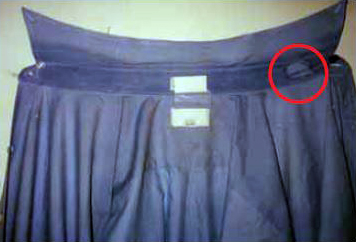
The dye distribution in the neck of this shirt has been caused by body oils during wear. The “light” spot on the right side is a cleaned-up area made by a drop of dry cleaning solvent.
WHAT IS THE PROBLEM?
Shirts can sometimes show areas of dye disturbance after laundering.
WHAT DOES IT LOOK LIKE?
Close examination reveals that the stained areas are mainly on the fabric where it comes into contact with the body, such as the neck, chest, or upper back. On solid colored (usually darker) shirts, the discoloration appears darker. On striped or plaid shirts, the staining looks like dye migration into the lighter areas.
WHAT CAUSED IT?
The dyes on these shirts are completely colorfast to all washing formulas, but the color is disturbed by contact with chemicals in perspiration, body oils, lotions, and other skin preparations. What appears to be a foreign stain is actually dye bleeding from the shirt itself, resulting in self-staining. Many times, this discoloration becomes more noticeable after washing when the water soluble soils are removed.
CAN IT BE PREVENTED?
Only the shirt manufacturer can prevent dye damage from normal wear by using dyes that are not only colorfast to accepted washing formulas, but also durable to perspiration and body oils that the fabric would be expected to come into contact with during wear.
WHO IS RESPONSIBLE?
Drycleaning and laundering are total immersion processes. The entire shirt and all its components receive the same treatment, so it does not cause this type of local dye transfer. The shirt owner has no reason to suspect that the shirt could be damaged by perspiration and body oil during normal wear. Therefore,the manufacturer is responsible for this type of dye problem.
IS THERE A REMEDY?
Fortunately, this type of dye problem can usually be removed by professionally dry cleaning the shirt several times. The shirt can then be commercially re-laundered and returned to wear.
